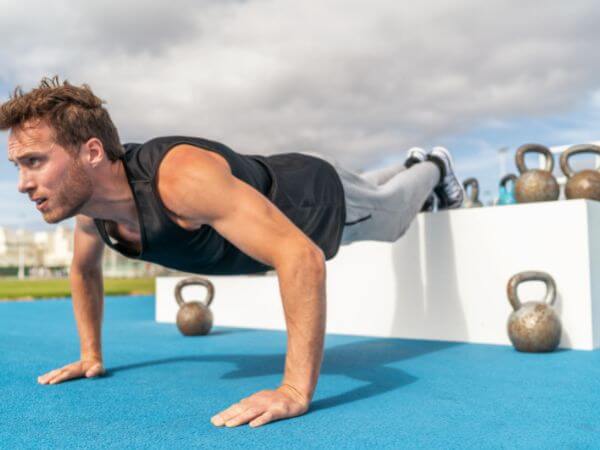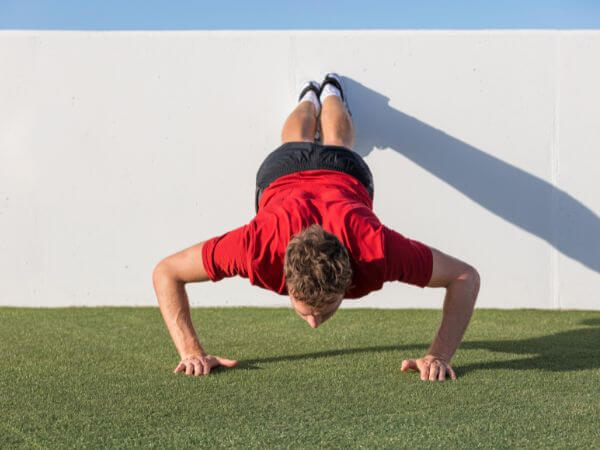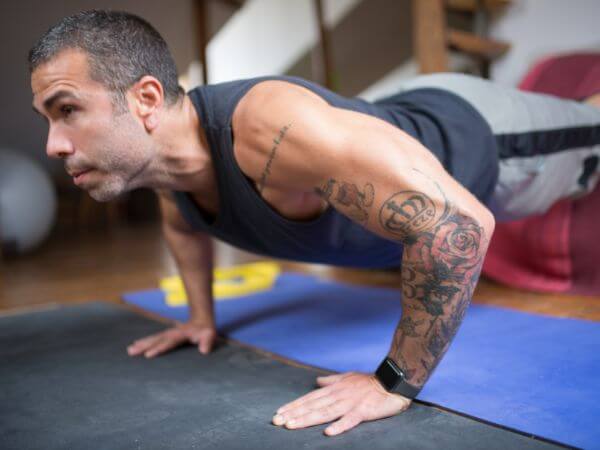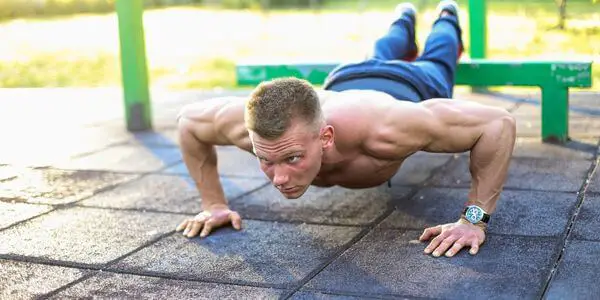Push-ups are a great way to build strength and endurance in your chest, shoulders, and triceps. However, many people struggle to see results with the traditional push-up after some time.
Here’s the solution:
If you want to take your push-up game to the next level, try decline push-ups.
Decline push-ups are a more challenging variation of the standard push-up that will work your muscles harder and help you achieve better results. This blog post will discuss how to do decline push-ups correctly and how they can help improve your overall fitness.
Keep scrolling below.
Table of Contents
How to Master Them
Decline push-ups are a great way to really work your chest and triceps.
Here’s how to do them:
- Find something elevated – a couch, chair, table, or even a sturdy toy box will do the trick.
- Place your hands on the ground shoulder-width apart.
- Position your feet on the elevated surface so that your body forms a straight line from head to toe.
- Bend your elbows and lower your body until your chest is just above the ground.
- Pause for a moment, then push yourself back to the starting position.
Remember: Keep your core engaged throughout the entire exercise.
Start with three sets of ten reps and work your way up from there. Before you know it, you’ll be a decline push-up pro!
Mistakes to Avoid

Doing decline push-ups is not as easy as it sounds. You have to be very wary of not making the mistakes below:
- Sagging your hips: This is a common mistake people make when doing decline push-ups. Remember to keep your body in a straight line from head to toe throughout the entire exercise. Otherwise, you can put too much pressure on your lumbar spine and get injured.
- Bouncing off the ground: Bouncing off the ground decreases the muscle work decline push-ups are meant to provide. Lower yourself slowly and under control, then press back equally slowly.
- Keeping your hands too much in front or the back: This position puts extra stress on your shoulders, elbows, and wrists, increasing your risk of injury.
- Lifting your butt to heaven: This position defeats the purpose of a decline push-up, making it too easy for your chest, triceps, and core. Make sure there’s always a straight line from your feet to your shoulders to reap the whole range of decline push-up benefits. To do that, keep your core engaged and your legs tight.
Pro Tips

Decline push-ups are scalable push-up variations, meaning you can always make them harder (or easier).
If you need more of a challenge:
- Place your feet on two separate objects instead of just one. The reason is to create more of a challenge for your upper body and core.
- Try a higher plyo box to put your feet on. This variation’s purpose is to increase the force exercised on your upper body.
- Don a weighted vest. Increasing the weight that your upper body has to lift means better-sculpted muscles.
- Try doing decline push-ups with one arm. This will force your stabilizing muscles to work even harder and will really test your strength and endurance.
If you need less of a challenge:
- Try decline push-ups from your knees. This variation is excellent for those who want to get used to the decline push-up movement before trying it from their toes.
- Elevate your feet less. A lower decline will make this exercise easier on your body while still providing some chest and triceps work.
- Wear a resistance band above your elbows. This way, you will stabilize your upper body more and increase your range of motion.
Benefits

Doing decline push-ups comes with a wide range of benefits:
- Injury prevention: Decline push-ups help strengthen the stabilizing muscles around your shoulder blades and scapula, thus preventing injuries such as rotator cuff tears.
- Improved shoulder mobility: Decline push-ups also help improve the range of motion in your shoulders. The reason is that decline push-ups force your shoulder blades to move through a greater range of motion than regular push-ups do.
- More muscle definition: Decline push-ups allow you to overcome strength-training plateaus and sculpt your muscles efficiently.
- More motivation: Knowing that decline push-ups are more challenging than regular push-ups can give you the extra motivation you need to stay on track with your fitness goals.
- Increased endurance: These push-ups help improve your muscular endurance, meaning you’ll be able to do more decline push-ups (and regular push-ups) over time without getting as tired.
- Improved cardiovascular health: Decline push-ups are a great way to get your heart rate up and improve your cardiovascular health.
Muscles Worked
Decline push-ups work similar muscles to regular push-ups. However, you can notice some significant differences.
- Improved chest and triceps definition: This decline push-up variation hits your upper body muscles – namely, your chest, shoulders, and triceps – much harder than regular push-ups. As a result, you’ll see improved muscle definition in these areas, even if you’re doing fewer push-ups.
- Stronger core: Since decline push-ups force you to keep your body in a straight line, they’re also great for working your core muscles. A strong core is essential for good posture, balance, and stability.
- More shoulder impact: Decline push-ups also place more emphasis on your shoulders than regular push-ups do. As a result, you can expect improved strength and definition in your shoulders with a decline push-up training.
- Glutes and legs: Elevating your legs during decline push-ups also forces your glutes and legs to work harder. The result is toning your glutes and legs better than a traditional push-up.
Alternatives
Alternatives to decline push-ups can be categorized into bodyweight exercises and gym machines you can use.
Bodyweight exercises that work similar muscles include:
- Pike push-ups: Best for shoulders
- Diamond push-ups: Best for triceps
- Incline push-ups: Best for chest and upper back for beginners
Gym machines that work similar muscles include:
- Pec deck machine: Best for chest
- Lat pull-down machine: Best for upper back and shoulders
- Cable flies: Best for your upper back and chest
- Spin bikes: Best for total body muscle tone and fat-burn
- Rowing machines: Best for whole body muscle building
Wrap Up
Decline push-ups are a great way to improve your upper body strength and definition. They also prevent injuries, improve shoulder mobility, and increase muscular endurance.
So if you’re looking for a new challenge, give decline push-ups a try.
You’ll thank us later.
- What Happens To Your Body When You Do Dips Every Day - June 28, 2024
- 9 Push-Up Mistakes You Might Be Making (And How to Fix Them) - October 10, 2022
- The Complete Guide to Mastering Upper Chest Push Ups - October 10, 2022

